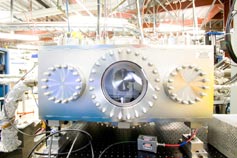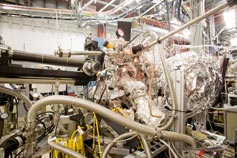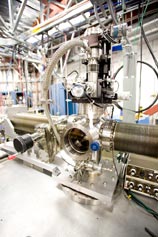
Handy Links
SLAC News Center
SLAC Today
- Subscribe
- Archives: Feb 2006-May 20, 2011
- Archives: May 23, 2011 and later
- Submit Feedback or Story Ideas
- About SLAC Today
SLAC News
Lab News
- Interactions
- Lightsources.org
- ILC NewsLine
- Int'l Science Grid This Week
- Fermilab Today
- Berkeley Lab News
- @brookhaven TODAY
- DOE Pulse
- CERN Courier
- DESY inForm
- US / LHC
SLAC Links
- Emergency
- Safety
- Policy Repository
- Site Entry Form

- Site Maps
- M & O Review
- Computing Status & Calendar
- SLAC Colloquium
- SLACspeak
- SLACspace
- SLAC Logo
- Café Menu
- Flea Market
- Web E-mail
- Marguerite Shuttle
- Discount Commuter Passes
-
Award Reporting Form
- SPIRES
- SciDoc
- Activity Groups
- Library
Stanford
Around the Bay
A Beamline is Born
Synchrotron scientists are accustomed to shuffling equipment around the lab, moving detectors and experimental chambers as needed for different experiments. One recent move at the Stanford Synchrotron Radiation Laboratory took the idea a step further, relocating most of Beamline 5 to create an entirely new experimental facility, the dedicated soft X-ray Beamline 13.
The new Beamline 13 enables a variety of spectroscopic and imaging techniques using soft X-rays, which have a longer wavelength than "hard" X-rays and occupy the lower half of the X-ray energy spectrum. Two Beamline 13 branch lines started operation in late 2007. Now, at the start of the new beamline's second season, the final pieces are coming together, with an additional branch line set to enter service.
Branch line 13‑1 is home to a scanning transmission X-ray spectro-microscope and is the newest addition to Beamline 13. Set for completion by the end of the current shutdown period, this branch line will help scientists to explore the mechanics of magnetism on an atomic level in a variety of new materials.
The device at branch line 13‑2 is actually a collection of instruments and was the workhorse at Beamline 5.2 before the move. At 13‑2, environmental scientists probe the nature of catalytic reactions, study how materials and gases interact and investigate the molecular behavior of water, among many other things.
The endstation at branch line 13‑3 has also seen plenty of action. Before returning to SSRL, the experimental chamber itself traveled to Germany for a tour of duty at BESSY in Berlin, while preparations continued at the new beamline here. This machine in some ways plays a role complimentary to the microscope at 13.1, giving researchers another way to image complex materials on the molecular scale. Because 13.3 uses the fraction of X-rays from the synchrotron that are coherent, or laser-like, it is also an important test bed for techniques being developed for the Linac Coherent Light Source.
Although Beamline 13 has been operational for less than a year, it is already producing great science, with a handful of recent papers published in a variety of journals. Upgrades to the beamline are already in the works. But for now, thanks to efficiency gains realized during the recent move, researchers still have a lot of exciting ground to cover.
—photos and text by Brad Plummer
SLAC Today, October 9, 2008


